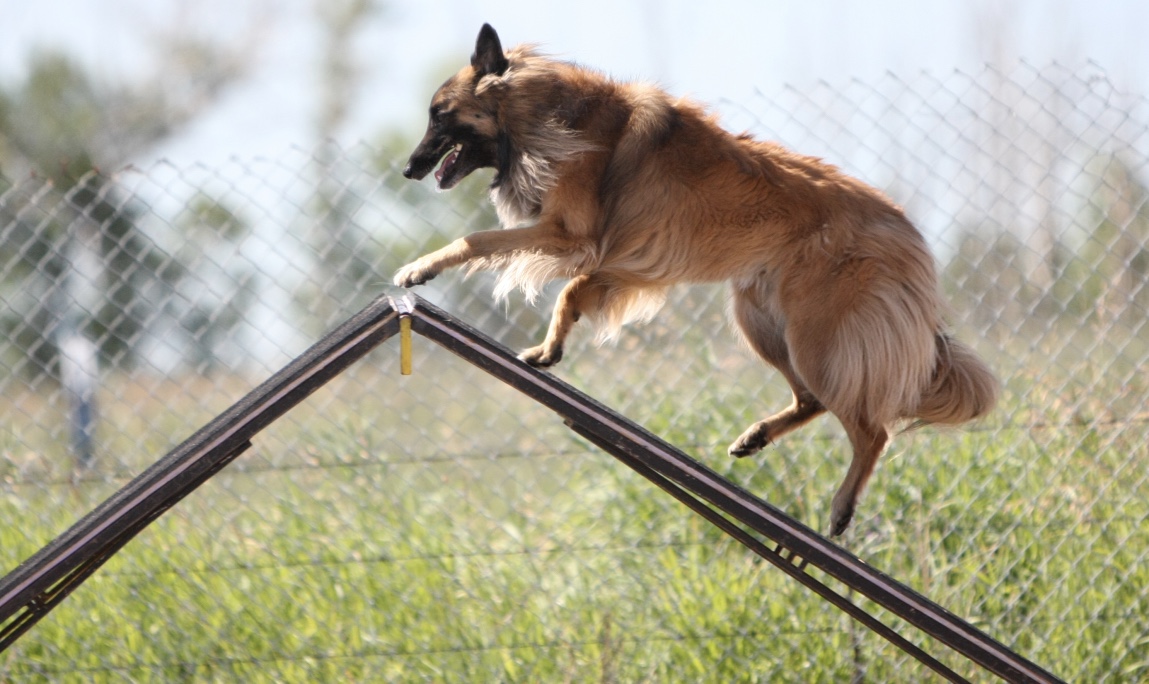Laurie's Blogs.
Mar 2017
Muscle Activation During Agility Tasks – Literature Review
Laurie Edge-Hughes, BScPT, MAnimSt, CAFCI, CCRT

This blog is by special request… this is for you, Dr. Carole Nicholson, DVM, CCRT, CVSMT. An analysis of the paper:
https://bmcvetres.biomedcentral.com/articles/10.1186/s12917-017-0985-8
The magnitude of muscular activation of four canine forelimb muscles in dogs performing two agility-specific tasks
Kimberley L. Cullen, James P. Dickey, Stephen H. M. Brown, Stephanie G. Nykamp, Leah R. Bent, Jeffrey J. Thomason and Noël M. M. Moens
BMC Veterinary Research, 2017, 13:68
Background: The purpose of this study was to measure the muscular activation in four forelimb muscles while dogs performed agility tasks (i.e., jumping and A-frame) and to provide insight into potential relationships between level of muscular activation and risk of injury. Muscle activation in eight healthy, client-owned agility dogs was measured using ultrasound-guided fine-wire electromyography of four specific forelimb muscles: Biceps Brachii, Supraspinatus, Infraspinatus, and Triceps Brachii – Long Head, while dogs performed a two jump sequence and while dogs ascended and descended an A-frame obstacle at two different competition heights.
Results: The peak muscle activations during these agility tasks were between 1.7 and 10.6 fold greater than walking. Jumping required higher levels of muscle activation compared to ascending and descending an A-frame, for all muscles of interest. There was no significant difference in muscle activation between the two A-frame heights.
Conclusions: Compared to walking, all of the muscles were activated at high levels during the agility tasks and our findings indicate that jumping is an especially demanding activity for dogs in agility. This information is broadly relevant to understanding the pathophysiology of forelimb injuries related to canine athletic activity.
So firstly, when doing my Master’s Degree, and being trained to critically evaluate research, we were tasked with looking at papers to decide, ‘Is this research that matters?’ There is a great deal of research out there that is research for research’s sake. Additionally, I remember being terribly frustrated, as a clinician, trying to choose a research topic that was ‘doable’ and ‘provable’ and ‘narrow-enough’ that it could be a single research project. Easier said than done! As clinicians, we want research that makes a difference to us clinically, however, all of the pre-clinical / academic research that leads to clinical research needs to be put in place first. This is one of those papers. In fact, one line in the paper summed up this thought: “…the state of the art for analysis of fundamental biomechanics in canines is decades behind human and equine science.”
Now, that being said, what were the golden nuggets from this paper?
- Dogs activate their Biceps (BB), Supraspinatus (SP), Infraspinatus (IF), and Long Head of Triceps (LHT) more during jumping or going over an A-frame as compared to walking. (This may seem obvious, but without research to validate, it is an assumption. Again, foundational research to base further research upon.)
A-FRAME ASCENDING
- Ascending the A-frame saw the greatest muscle activation occurring during swing phase of the stride.
- Ascending the A-frame was where Infraspinatus had the greatest activation.
- Other muscles were activated during ascending, but less than IS.
A-FRAME DESCENDING
- Descending the A-frame revealed the greatest muscle activation occurred during the stance phase of stride.
- Supraspinatus had the highest muscle activation while leaving the A-frame (after descending). Descending the A-frame had the second highest activation for SP.
JUMPING (And for the record I found the different phases of the jump to be poorly defined and confusing. They were not broken down enough to be entirely useful data.)
- All muscles showed a peak activation at:
- swing phase (i.e. early take off?)
- Early stance (i.e. landing?)
- Mid swing (i.e. going over the jump?)
- Long head of Triceps as well as the Biceps had the highest activation at the early take off phase of a jump.
- For supraspinatus, jumping (i.e. going over the jump) yielded the second highest activation, akin to descending the A-frame, for this muscle.
The clinical relevance of this paper
Does this paper tell us why injuries occur on these pieces of equipment or to which muscles?
NO.
Does this paper guide our clinical decision making?
NOT REALLY.
What is the only fair clinical hypothesis we can take away from this paper as Rehabilitation Professionals?
Be sure to retrain jumping tasks and ascending-descending tasks during your rehabilitation of the Surpraspinatus, Biceps Brachii, Infraspinatus, or Long Head of Triceps injuries in an agility dog.
Is this paper a stepping stone for future research?
YES, and maybe that’s where we leave it.
There you have it! I know you were hoping for more, but any other interpretations would be mere speculation and reading into the paper what isn’t really there.


